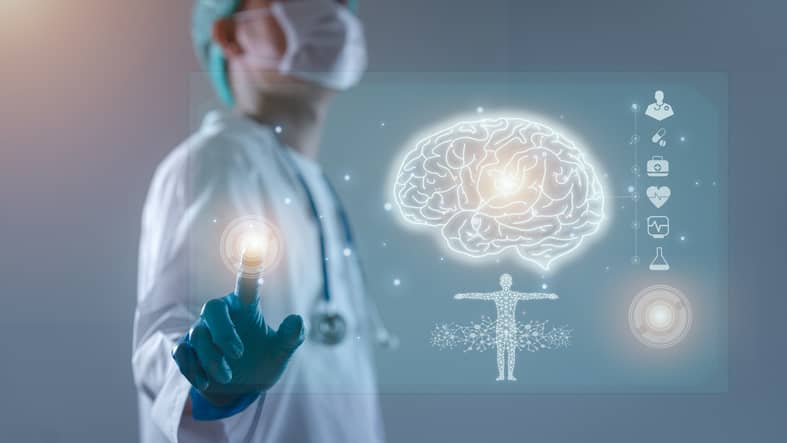Ambient artificial intelligence (AI) is a new way of thinking about computers and natural human-computer interaction. It enables you to interact with technologies in a more conversational, nondisruptive way while handling basic tasks such as performing calculations and queries and making real-time recommendations.
This technology is built on the premise that computers should be responsive, proactive and intuitive. Its goal is not to replace humans with machines but instead to enhance human capabilities by working in collaboration with them.
This post takes a closer look at ambient AI, how it differs from traditional AI, and the ways it’s influencing healthcare and patient care.
What is Ambient Artificial Intelligence?
Ambient AI combines machine learning, data analytics and natural language processing with humanlike behavior to provide personalized experiences for patients.
It has broad uses in healthcare, such as:
- Improved patient care: Ambient AI can be used to provide personalized care for patients based on their condition and history.
- Operational efficiency: Ambient AI can help improve the coordination of hospital operations by monitoring staff performance, identifying bottlenecks in workflow processes and providing real-time information about how well these processes are working.
- Information extraction: Ambient AI can help health systems extract data from electronic medical records (EMRs) in order to improve patient care, identify opportunities for cost savings or meet other operational needs.
Ambient AI provides healthcare professionals with a powerful way to identify and address specific challenges in the healthcare industry and provide a more personalized experience in patient care.
What is the Difference Between Ambient Intelligence and Artificial Intelligence?
Artificial intelligence is a broad field that encompasses many areas, including machine learning and deep learning. Ambient AI is a subset of AI that focuses on the creation of intelligent systems that can solve problems in real time and at scale.
The term “ambient” refers to the fact that the AI exists in the background until it receives a context cue letting it know that it needs to act. In a clinical setting, that could mean a patient walking into a room and the system recognizing their ID badge, or the system noticing that a patient has been sitting in the waiting room for two hours. Ambient AI is designed to work seamlessly behind the scenes, without requiring any human intervention.
It also allows for the creation of systems that are even more intuitive and responsive. Quantum computing in healthcare, for example, offers the potential ability for systems to work through vast amounts of information created by electronic health records, biomedical research and medical devices connected to the internet of things. The key to making this happen is machine learning, which allows systems to learn from their interactions with humans so that they don’t just respond but anticipate human needs. This allows healthcare institutions greater control over their systems and potentially even enables them to design more secure, efficient and effective solutions.
The Main Characteristics of Ambient AI
Ambient AI’s achievements encompass three basic categories: context-awareness, intelligence and ubiquity.
- Context awareness means that an ambient AI device needs to know how it’s being used at any given time and what kind of response would be most appropriate for the situation at hand.
- Intelligence refers to an ambient AI leveraging algorithmic support in decision-making and optimizing system processes.
- Ubiquity means that an ambient AI device needs to centralize information from various places to extend the perception and interaction to the ambient, enabling the use of available devices, objects, and other entities.
Previous iterations of AI have lacked contextual awareness, making it difficult for it to recognize when language is being used in different ways, much less respond appropriately. An ambient AI device, on the other hand, can recognize greater degrees of nuance in its environment — it can know what doctors need before they ask for it, for example, and offer it up without being asked.
This technology has the potential to fundamentally change the way hospitals and other medical facilities operate.
AI’s Role in the Future of Healthcare
The future of AI in healthcare is going to be a world of ambient clinical intelligence offering more intuitive practices to the processes and operations of healthcare professionals. Its goal is to make life easier for doctors, nurses and patients alike by bringing together all the disparate data sources they use every day into one centralized location that they can access from any device at any time.
Clinicians can use ambient AI to:
- More easily access patient records from different institutions and systems, including electronic health records (EHRs) and external applications like electronic lab results or imaging studies. Patient information will be available regardless of where it was generated or stored.
- Access real-time analytics to quickly identify issues with patients’ care plans or treatment regimens. This allows them to avoid unnecessary readmissions or costly complications down the road.
- Quickly access alerts about patients who might need attention soon — whether those alerts are issued by their own EHR systems or by other institutions’ systems.
Other Practical Uses of Ambient AI in Healthcare
Ambient clinical intelligence combines developments from AI, machine learning and voice recognition software to transcribe and interpret healthcare documentation. It utilizes the latest advances in computing technology to make it easier for companies to integrate new forms of data into their existing workflow.
Instead of taking painstaking notes during a patient interview, doctors can communicate naturally while ambient AI works in the background to automatically convert their words into a digital record. It records and captures the nuances of their voice, including pauses and inflections. The results integrate seamlessly into the patient’s electronic health records, allowing doctors to access the data at any time.
Ambient AI could predict when a patient might need assistance or care — it could also be used in the operating room or at a patient’s bedside to help surgeons make complex decisions about surgery or medication plans based on data from other patients with similar conditions.
In other words, ambient AI can help automate tasks like ordering medications, scheduling appointments and making sure the right doctor sees patients in a timely fashion. Ambient AI can also be used to simplify data collection and analysis tasks, allowing doctors to spend more time with their patients rather than on administrative work.
The Promise of Ambient AI
Far from creating more distance between doctors and patients, ambient AI can instead be used to create a more human-centered experience for patients. It can help doctors better understand their patients’ needs and preferences, which in turn can lead to improved healthcare outcomes for all involved. The idea is to eliminate as much needless paperwork and as many redundant operational and administrative tasks as possible, allowing doctors to spend more time with their patients and less time on administrative tasks. That’s what ambient intelligence means for healthcare — efficiency and seamless interoperability.
Such technologies will play an ever more important role in the future of medicine. Students of data science, healthcare analytics and machine learning should be aware of this trend and prepare themselves accordingly. The USF Health Morsani College of Medicine offers graduate certificates in health informatics and analytics, offering students a pathway into healthcare data science.
Explore USF Health’s innovative graduate certificates and master’s programs designed to equip healthcare professionals with the tools to embrace tomorrow’s emerging healthcare technologies.



